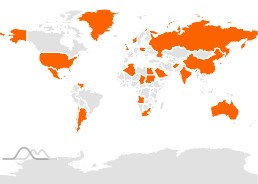By Jason Finkelman.

Upon Spurlock Museum’s invitation to curate an exhibition on the Japanese American experience, Jason Finkelman proposed telling the story through profiles of those who had been part of the University of Illinois as students, faculty, and staff. Seeking subjects who had been part of the institution before, during and after the World War II incarceration of over 125,000 Japanese Americans, Finkelman turned to the University Archives to discover and research several of the twelve profiles on display through December 10.
As a Philadelphia-born Yonsei, a fourth generation Japanese American, Finkelman had long pursued knowledge of his Japanese ancestry utilizing historical documents available online and within the WWII Japanese American Internment and Relocation records of the U.S. National Archives. Nikkeijin Illinois provided an opportunity for Finkelman to better understand Chicago and Midwest Japanese American histories, starting with the fact that only 390 citizens of Japanese descent resided in Chicago in 1940. This community increased to 20,000 by 1945-46, relocating to the city for employment and education opportunities outside the ten incarceration centers.
One example of University Archives-based research Finkelman pursued extensively was piecing together the story of Seichi Bud Konzo. Arriving in 1927 as a Research Graduate Assistant Fellow in Mechanical Engineering, Konzo enjoyed an award-winning, lifelong career and affiliation with UIUC spanning over 50 years. First brought to Finkelman’s attention in Bill Hosokawa’s historical monograph Nisei – The Quiet Americans (1969; William Morrow and Company, Inc.) Konzo is listed as attending the inaugural Japanese American Citizens League national meeting in Seattle in 1930 “from Urbana, Illinois, where he was going to the University of Illinois.”

A bound edition of Japanese Students’ Christian Association newsletters discovered in the student life and culture archives revealed Konzo also served as the 1930 Midwest Representative of this North American organization. During WWII, Konzo’s employment outside of the West Coast military exclusion zone allowed him to maintain his station at the University of Illinois as a research professor and to contribute to the war effort as a fuels consultant for the U.S. Army Corps of Engineers from 1941-1945. In the archives Finkelman discovered an open letter from University Counsel Sveinbjorn Johnson dated December 10, 1941, declaring Konzo as a loyal citizen of the United States and fourteen-year faculty member of the University, who is required to travel to Cleveland, Ohio on December 11 to consult on “heating plants for defense housing units.” This fascinating document serving as a type of “official” university “leave clearance form” and confirmation of loyalty is included in Konzo’s profile at Spurlock Museum.
Along with the exhibited Nikkeijin Illinois profiles, Finkelman pursued understanding the evolution of University of Illinois policies on admitting Japanese American students during the war years. Research in the archives was critical to the College Nisei story display panel. After President Roosevelt’s signing of Executive Order 9066 on February 19, 1942, approximately 2500 Nisei students enrolled in West Coast colleges were forced to withdrawal from their programs. As early as March 1942, after receiving numerous transfer inquiries from institutions and students within the Western Military Zone, president W.C. Coffey of the University of Minnesota, corresponded with UIUC President Arthur C. Willard regarding policies to admit Japanese American graduate students. Willard responded, “I do not believe the Board of Trustees and other authorities of this institution look with favor upon the admission of either Japanese aliens or Americans of Japanese ancestry.” This statement was followed in April 1942 by President Willard’s administration adopting a no admissions policy claiming the University of Illinois a military exclusion zone due to government sponsored research and proximity to Chanute Air Force Base.
Under continued pressure from various agencies including the National Japanese American Student Relocation Council working under the War Relocation Authority, the Board of Trustees approved an arduous policy for admittance of Japanese American students in March 1944. The BOT public record states, “The Registrar has been studying this matter and he recommends that the University agree to admit… under the following conditions.” This one statement set Finkelman on a deep archives dive to uncover any record of the Registrar’s report. With the discovery of an undated two-page summary titled “Policy With Respect To Admission Of Students Of Japanese Ancestry”, along with an attached third statement from University of Michigan dated January 31, 1944, Finkelman enriches the record of the College Nisei story by providing access to a unique overview of the policies followed by fourteen peer Midwest institutions.

Curated through research in the University Archives, as well as in historical newspapers and online Japanese American WWII documents, Nikkeijin Illinois is a revelation of the dynamic histories and events of the Japanese American experience through stories of those who are part of the University of Illinois record.
Finkelman will offer a lecture titled “Nikkeijin Illinois – Extended Stories” on October 6, 2023 at 12:00 PM as part of the Friday Forum + Conversation Café series presented by Diversity and Social Justice Education and University YMCA, sharing new information learned since the exhibition opened in February.
